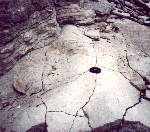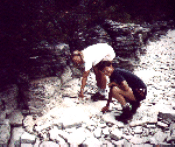The Thornloe Formation
 The Thornloe Formation has been interpreted as resulting from conditions favorable for biostromal accumulation, ie. a reef building environment.
The Thornloe Formation has been interpreted as resulting from conditions favorable for biostromal accumulation, ie. a reef building environment. A biostrome is a distinctly bedded and widely extensive or broadly lenticular blanketlike mass of rock built by and mainly composed of the remains of sedimentary organisms; an "organic layer". The higher up the stratigraphic column one goes, the more concentrated coral fossils become, indicating an evolution from a pioneer to a fully mature reef community, with niche-filling well underway. Shown here are "Mega-Ripples", a sedimentary structure associated with storm deposits, adding further proof of an active marine environment. Geology students in the right photo are there to show some sense of scale. Other rock types in the area include Oolitic limestone, made up primarily of ooliths that have been cemented together and stromatalites in the upper sections. Fossils in this section include Stromataporoid, tabulate corals such as Favosites and abundant disarticulated crinoid ossicles. Examples of fossils in the area in-situ are shown in the palentology section.
A biostrome is a distinctly bedded and widely extensive or broadly lenticular blanketlike mass of rock built by and mainly composed of the remains of sedimentary organisms; an "organic layer". The higher up the stratigraphic column one goes, the more concentrated coral fossils become, indicating an evolution from a pioneer to a fully mature reef community, with niche-filling well underway. Shown here are "Mega-Ripples", a sedimentary structure associated with storm deposits, adding further proof of an active marine environment. Geology students in the right photo are there to show some sense of scale. Other rock types in the area include Oolitic limestone, made up primarily of ooliths that have been cemented together and stromatalites in the upper sections. Fossils in this section include Stromataporoid, tabulate corals such as Favosites and abundant disarticulated crinoid ossicles. Examples of fossils in the area in-situ are shown in the palentology section.
 Cobalt Geology
Cobalt Geology
 Cobalt Paleontology
Cobalt Paleontology